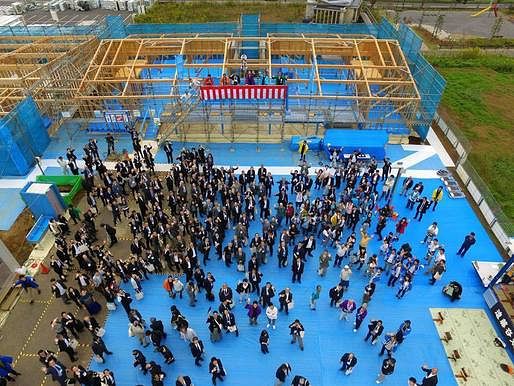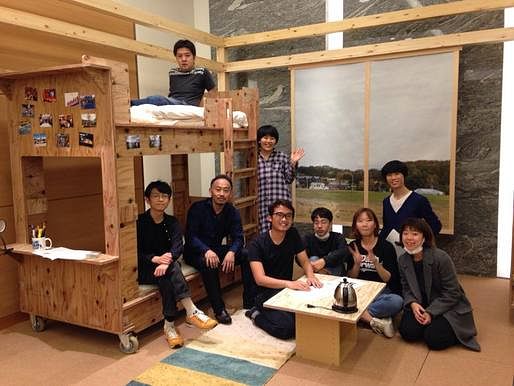

Over the next five years our students will design and build five dormitories and workshops on a piece of land adjacent to the main campus. As a way to learn about architecture its a pretty good one, especially since we are tying to push the limits a bit, and the limits are pushing back.
Professional builders did a lot of the work in the first project shown in the photos here, but right now there are two really interesting building designs underway, one with Shigeru Ban, and one with Hiroto Kobayashi. Both are using non-accredited structural systems, being made from cardboard and plywood, and as a result the push-back on how to move forward is not easy. Experience with earthquakes is deeply embedded in the building code (rightfully so) and structural regulations, so its not easy to convince the municipal government that a permanent building made of these materials would be safe. Solving that problem is a cool part of the education of a modern architect. Building with our own hands is awesome of course, but learning how to pull the right levers in a bureaucratic system in order to do extraordinary things has got to be the best kind of education for anyone who wants to color outside the lines as part of their professional practice. Even when we are stopped it is a useful thing to have gone through, because we learn about what is important and why, and can begin to design with those lessons in mind. It is likely that this is a topic I will need to return to as the next buildings make their way through design development and then construction.
In the meantime, here is what we did last year.
The entire project started as a joint studio with Kazuyo Sejima.
 the assignment was to design a series of dorm rooms and workspaces on the actual building site. Impressively, if the students could come up with a good design, ideally something students could build themselves, then we were motivated to carry out their ideas. As a crit I found Sejima to be very much on point and gave strong advice to the students about planning and construction that to be honest was a bit surprising. While her own built works are quite abstract she has built so much now that she is completely at ease describing the reasons buildings might be distributed over a site, and how they might be built - connecting concepts to the real world in very unambiguous ways, and entirely archi-babble free. I don't know if the students were catching everything she had to say but I sure was paying attention.
the assignment was to design a series of dorm rooms and workspaces on the actual building site. Impressively, if the students could come up with a good design, ideally something students could build themselves, then we were motivated to carry out their ideas. As a crit I found Sejima to be very much on point and gave strong advice to the students about planning and construction that to be honest was a bit surprising. While her own built works are quite abstract she has built so much now that she is completely at ease describing the reasons buildings might be distributed over a site, and how they might be built - connecting concepts to the real world in very unambiguous ways, and entirely archi-babble free. I don't know if the students were catching everything she had to say but I sure was paying attention.
Some of the ideas generated in the studio were carried forward, but in the end the university pushed for a pretty orthodox building to start with. In Japan that meant a timber frame, with all connections reinforced by high spec hardware, and all of the joints cut by milling machines. Joints between posts and beams are traditional, complex, and fascinating because they interlock so perfectly. But none of them are cut by hand anymore, which is probably why the building method is still around - cheap but high end, all dependent on an army of well-trained robots. As an observation it's interesting on its own but there are consequences to building this way. Very little is built here using 2x4 or 2x6 construction, which means students have less to do than might be the case in North America when a similar project is taken on.
The wood pieces are heavy, thick, and labeled like an IKEA set, and it takes heavy machinery to put them in place. The next round of projects will likely be fabricated on the campus and then we will need more student involvement, but for now it's still pretty cool to join in with construction even if the opportunities are fewer.





the building itself is a simple plan, with showers, dorm rooms, a CNC workshop, a large studio/workspace, and a kitchen, amounting to about 450 square meters (4500 sqft) when all said and done. So far the completed building has seen a lot of use as a meeting place for workshops and other activities, including a kick-off event where students designed and built bunk beds for all of the rooms, making use of the new CNC workshop as a base.

The first building is a bit curious right now sitting on the land on its own, surrounded by suburban homes and a highway. If all goes well there will be 2 or 3 new buildings to go with it in the next 6 months, and hopefully that will work as a starting point for building a community, reaching out to the people living around the campus, and becoming a focal point for people to hang out.
One of the things I really like about this project is that it is ambitious not only as a project for students, but for the area. Our campus was designed by a single architect more than 25 years ago on a large piece of farmland. Since then there has been no development outside the campus except for a few suburban homes and a lot of factories. There are no shops or cafes, no restaurants or bars, supermarkets, or any of the things that tend to accumulate around a university. Instead we have a ring of trees, beautiful and soothing, acting as a kind of wall or moat. The student built campus is intended to break that mold. I have high hopes. Once students actually become a visible part of the community they have parked in for the last 20 some years things are bound to change in an interesting way.

keio university's architecture program is probably the best kept secret in the country. Hidden away on a campus an hour from tokyo the curriculum is wide open and connected to a campus-wide project aimed at community-driven innovation. students of economics can take courses in architecture and vice versa but we all are expected to take part in real projects somewhere in the world. there are a few starchitects on the faculty but mostly we are hoping to make a difference.
2 Comments
Love seeing projects like this. Thanks for posting.
Hi there thank you for the interesting posts! I'm an architecture student from South Africa. I am looking to do my graduate degree in Japan. It seems like Keio's architecture department really is a well kept secret because I can't seem to find any information about it. Does Keio have graduate programs? And if so, do you possibly have any advice for how I could contact the department?
https://archinect.com/blog/article/149951035/studying-architecture-in-japan
Block this user
Are you sure you want to block this user and hide all related comments throughout the site?
Archinect
This is your first comment on Archinect. Your comment will be visible once approved.